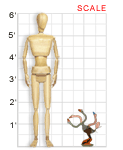VAM galleries including this work:
Kentucky Museum of Art and Craft | Animal Farm | Young at Art || VAM Home
Marvin Finn (Kentucky, b. 1917)
FOUR-HEADED GOOSE, 1983
Painted wood, 22" X 23"
Kentucky Museum of Art and Craft
Four-Headed Goose is a work of painted wood by one of Louisville’s most celebrated folk artists. Although Marvin Finn is a living, working artist in the heart of the city, it is important to note that he spent his childhood in the rural South. His works often depict country animals such as chickens, roosters, horses, and bulls. Finn uses scrap wood to cut the profile of the animal and often paints his works using colored stripes, dots, and dashes against a solid color background. In addition to his animals, he is known for creating complex cranes, shovels, and bulldozers like those he watched while working as a laborer in the Louisville dockyards. In 2001, large metal replicas were made of some of Finn’s wooden birds and put on display in downtown Louisville. This public art project was called “A Flock of Finns.”
About the Artist
Video Clip
Information about Louisville’s “Flock of Finns,” a public display of Finn’s
work, from the KET series Mixed Media
Marvin Finn was born in 1917 near Clio, Alabama. He grew up on a farm and learned to whittle from his father. “There were ten boys and two girls in my family, and most of them were older than I was, so I didn’t have toys except when I made them,” he says.
“Maybe the good Lord plants these things in my mind. When I leave here and meet the good Lord, I ain’t never going to quit making toys. That’s what my mind tells me. That’s heaven to me—making toys—and I look forward to it all the time.”
Finn arrived in Louisville after World War II. After he married in 1952, he made toys for the enjoyment of his five children. His wife, Helen Breckinridge, helped him, using an electric saw to cut out the toy shapes that he had drawn. After his wife died in 1966, Finn kept making toys to help him through his grief. “Sometimes I’d wake up at 1:00 or 2:00 in the morning. I’d get up then, every morning, with something new in my mind,” he recalls. “I get up with an idea, and I’ve already got a head start.”
Finn’s work is highly regarded by collectors of toys and collectors of contemporary folk art around the world. “I think my work is pretty good as far as I’m concerned,” Finn says. “I never did get to finish school, but I’m pretty sharp with my imagination. I just do what my mind tells me to do. Maybe the good Lord plants these things in my mind. When I leave here and meet the good Lord, I ain’t never going to quit making toys. That’s what my mind tells me. That’s heaven to me—making toys—and I look forward to it all the time.”
Classroom Ideas
Discussion: Describe Marvin Finn’s Four-Headed Goose. How did Finn use the elements of art in this piece? Why do you think he chose to make a goose with four heads? Do you like the piece? Why or why not? Support your answer with specific details about the artwork.
Suggested Activity: Create your own “flock” in the style of Marvin Finn. Create a creature (real or fictional) and, using pencil only, draw it on a large piece of paper. Then paint it, adding bright colors, patterns, and textures. After the paint dries, you can cut out the animal shape. Write an artist’s statement about your piece. Display the entire class’s animals together.
If you have access to scrap wood, the animals can be wooden sculptures made with different shapes of wood. Craft stores often have dowel rods, wooden wheels, and geometrical wooden shapes that can be used as well. Use wood glue, drill guns, and screws to attach the pieces together.
Links
Read the article Marvin Finn: Wizard of Whimsical Whittling at the Kentucky Museum of Art and Craft web site.
[www.kentuckycrafts.org/Marvin_Master.htm]
The Flock of Finns site includes information about the public art project, photos of other Finn birds, and classroom resources such as outlines of bird shapes that students can print out and color.
[www.mobetter.com/pages/flock/pages/site.html]


